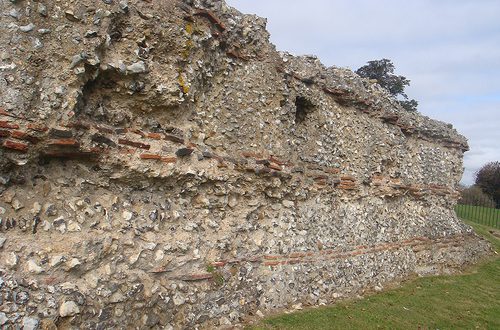 This week a group of archaeologists and volunteers from Colchester Archaeological Trust and Destination Colchester attained their goal to raise 200,000 to buy a plot of land that covers the remains of part of what was once the only known Roman Circus in Britain. The appeal started as recently as December 2009, and was quickly won, with the help of celebrity endorsements and public goodwill. We spoke to Philip Crummy, Director of the Colchester Archaeological Trust about the achievement.
This week a group of archaeologists and volunteers from Colchester Archaeological Trust and Destination Colchester attained their goal to raise 200,000 to buy a plot of land that covers the remains of part of what was once the only known Roman Circus in Britain. The appeal started as recently as December 2009, and was quickly won, with the help of celebrity endorsements and public goodwill. We spoke to Philip Crummy, Director of the Colchester Archaeological Trust about the achievement.
HK: Congratulations on raising the 200,000 sum you needed, how do you feel?
PC: We feel quite overwhelmed by it all, the response from the public has been fantastic, much better than we expected when we started and we’ve had all sorts of letters of support and donations that have made us think that what we’re doing is something people really want.
HK: And you’ve raised 200,000 so far, but I understand that there’s still a way to go.
PC: Well the 200,000 is roughly about a quarter of what we need to raise. That’s to pay for the public elements of the project. We have to raise around three times as much again. That’s a mixture of private money from investors to pay for other parts of the building and a mortgage for ourselves, the Archaeological Trust, to relocate into another part of the building – that will be about 230,000. We estimate there is another 150,000 worth of repairs required for the Sergeant’s mess building. Then we have two private investors to buy what space’s left in the building and bring in another 350,000 and that gets us pretty close to the total amount. So that’s how we’ll do it. The 200,000 pays for the public part of the project.
HK: What time-frame do you have in mind to complete the repairs and get the circus excavated and the reconstructions completed?
PC: We hope within this year to be ready to move in to the building and then to submit an application, which will take a good year, to the Heritage Lottery Fund, to raise the money to do the displays to kit out the interpretation centre to a high standard because that particular stage of the operation wasn’t included in the current fund-raising. So I guess to get to the end of the process will perhaps take to the end 2011 but if we can get into the building before that we will mount an interim display for the public to visit while all that’s going on – that could be in the autumn of this year.
HK: And how much archaeological work is there to do?
Well the archaeological remains are about a quarter of a mile long and they’re all underground. You can’t see anything at all, the remains are lying about a foot under the modern ground surface, so what we want to do, we want to bring that to the surface by using mounds along the places where the seats were, having the garden where the actual starting gates were, uncovering a small part of the remains and trying to do a three-dimensional reconstruction to show what the original gates looked like.
HK:Have you been to any other sites which would provide a good model for what you’re trying to do?
Well, around what was the Roman Empire you can find around ten circuses where what’s left is substantially exposed, or different parts of them are exposed. All of those are exposed because they’ve got huge chunks of stonework and masonry which, because of the climates in those parts of the world, can withstand exposure. Our climate gives us a different sort of problem and if we exposed the remains they would very quickly disintegrate. So that’s why we’re not proposing to actually attempt to expose the remains for any kind of length of time because they would decay. So what we’re going to do is use in part three-dimensional artwork and in part reconstructions.
If you walk around the footprint of the circus, which is a quarter of a mile long, it’s strange because you might think that there’s not much to go on but if someone explained to you what it all was and just put across the scale of the thing, and the positioning of it on the ground, it’s worth coming to see. But we want to go beyond that and give a three dimensional representation of the starting gates themselves. It’s the job of the interpretation centre to bring the whole thing to life and we’re actually working on a computerised visualisation for that.
HK: What you’ve achieved should really give hope to the next group of people trying to save a heritage project.
I think one of the reasons why it’s been as successful as it has been is because people, and I think it’s not just true of Colchester, feel that not enough is done with the heritage of the place. Colchester’s a very old city – it’s the oldest Roman town in the country and yet you could walk around the town centre and not get any sort of feeling about its Roman history. I think we got this response partly because we found this extraordinary old building but partly I think there’s a sense of frustration that more should be done about it. I think that, because of this appeal, over the next one or two years councillors will start to pay a bit more attention to that aspect and put it a bit higher up on their agenda.
Visit Roman Colchester
Colchester, ne Camulodunon (a Celtic name meaning ‘fortress of the war god Camulos’), was near the summit of our Ancient World in London video hitlist, being just 55 miles from London in Essex. And thankfully we had the perfect guide: Howard Brooks, of the Colchester Archaeological Trust. The trust have been discovering and preserving the city’s history for decades. And it’s clear that Howard has lost none of his passion for archaeology.
HK: Do you feel the council gave you enough help? I understand they donated 30,000.
Well we didn’t actually officially ask them for money – they made it clear there wasn’t any. What we’ve actually agreed to do is to gift to the council the garden around the starting gates, because what actually started this whole thing up was that the area around the starting gates, under the current planning permission, were going to be part of a private garden. We feel very strongly that this isn’t right. Something as important as that should be in the public ownership.
HK: How financially sustainable is the interpretation centre and display going to be?
Well we’re in talks with a major tea room company about leasing them part of the building. That will hopefully provide enough money to pay the running costs of the interpretation centre which actually won’t be very great. If we can get to that stage we feel there’s a really solid long-term business plan there that will allow us to do what we want to do. It’s about 10-15 minutes outside the town centre but the council have this idea that they’re going to develop to create a ‘heritage arc’, which will start at the museum, go up to St. Botolph’s Priory, which is not very far away, up to St John’s Abbey gate and then to the circus. It will tie the circus to the town centre and to the castle.
HK: What does your success tell us about the British public and their interest in heritage?
It tells us what we already know: that many, many people feel the past is of some value, of interest and that it adds to the character of where they live. People feel heritage counts, it’s a part of life, it’s a part of history and that it’s something we need to nurture and look after and I think the success of the appeal just reinforces that.





